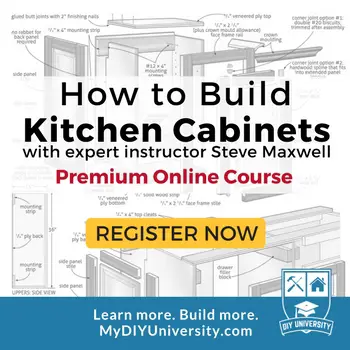
If you’re interested in saving tons of money building great kitchen cabinets, built-ins or a bathroom vanity, all while working in your garage or basement, then I’ve got some specific things to show you. In fact, I’ve already started showing people how to build cabinets like the ones you see here.
This past week I’ve been emailing with the newest group of home woodworkers who’ve signed up for an online course I teach regularly on building kitchen and bathroom cabinets in the home workshop, and their enthusiasm is a great thing to see. Folks are still signing up now for this current intake, and as I help the early birds finalize their designs, I’m reminded of how this whole cabinet thing started for me.
In November 1987, I unloaded my tools onto a workbench in a small commercial wood shop, alongside four other cabinetmakers busy at work. The team I joined was building custom-made, solid-wood kitchen cabinets at a place called Whippletree Kitchens just north of Toronto, Canada, and this is where I gained experience using real wood, hardwood veneered plywoods and the best hardware and joinery to make exceptional kitchens in a traditional style. I’d been looking for a place to work where I could build with great materials following great designs and Whippletree was certainly that place.
If you’re anything like me, you’ve noticed that while store-bought kitchen cabinets look good superficially, they’re usually built using the cheapest particleboard sheet goods and questionable hardware, all held together with questionable joinery. It’s a shame people don’t know what they’re buying. Even most $30,000 kitchens are surprisingly shabby underneath the fancy surface, made almost entirely with that loathsome particleboard I dislike so much. It’s heavy, weak and loaded with urea formaldehyde glue. But there’s a good news alternative. Click here for a video tour of the building approach I teach in my online classes.
If you’ve got intermediate or even basic woodworking skills, you can do much better building your own custom kitchen cabinets from high quality materials, while also saving at least 75% on the cost of ready-made cabinets. You might think this sounds crazy, but it’s true. You don’t need to be an expert cabinetmaker with a fancy shop to build great cabinets following the methods I’ve developed over the decades. All the photos here are of cabinets I’ve built using this approach and they’re the same thing I’m teaching the current group of learners over the next 6 weeks in my course.
Classic Kitchen Cabinets: How I Build Them

The method I use combines solid wood stiles, rails and raised panels to create a classic look in a very practical way. The trick involves building boxes made of hardwood veneered plywood first, then using these boxes as a foundation for securing solid wood stiles, rails and panels, followed by trim and doors. You get the accuracy of sheet goods with the unmistakeable classic beauty of authentic, solid wood frame and panel construction wherever it’s seen. It’s a super combination.
With boxes complete, it’s time to create frame and panel doors and cabinet ends. This is the classiest way to work solid wood into cabinets, and it involves three parts. Stiles and rails are the vertical and horizontal members that surround every solid wood panel.
One advantage of building solid wood details around a plywood box is the ease of fastening stiles and rails securely and with minimal joinery. Simply cut, glue and clamp stiles and rails to your plywood boxes with butt joints. Use nails only in those places that will be covered later by trim.
Raised panels are one of the things people love about solid wood cabinetry, and I have a unique approach for creating these panels in the home workshop. It involves just a tablesaw and a hand plane – no fancy router bits or router table needed. Click to watch one of the 43 teaching videos from my course that shows how to use a hand plane to make raised panels.
One of the most common questions I get from learners in my cabinet class has to do with joining stiles and rails and panels together for door and cabinet sides. You can spend a lot of money on fancy router bits for this job, but it’s really not necessary. In fact, the simple method I’ve settled creates results that look better and are more authentic than router-cut designs. Click to watch the video from my course that shows what I mean.
 Of all the ways workshop skills can improve your home, building kitchen and bathroom cabinets offers the greatest benefit. The thing is, complication of that work is simpler than most people think. Your efforts will pay off in big ways. Click below to learn more about the next kitchen cabinet course I’m running as an instructor with The Family Handyman’s DIY University. You can take the course anywhere in the world that offers an internet connection and you get one-on-one opportunities to ask me questions and work together. I’ve negotiate a 10% discount for any of my subscribers that sign up. Just use the discount code STEVEMAXWELL10 when you check out.
Of all the ways workshop skills can improve your home, building kitchen and bathroom cabinets offers the greatest benefit. The thing is, complication of that work is simpler than most people think. Your efforts will pay off in big ways. Click below to learn more about the next kitchen cabinet course I’m running as an instructor with The Family Handyman’s DIY University. You can take the course anywhere in the world that offers an internet connection and you get one-on-one opportunities to ask me questions and work together. I’ve negotiate a 10% discount for any of my subscribers that sign up. Just use the discount code STEVEMAXWELL10 when you check out.
Got any questions? Send me an email at [email protected] or give me a call at my home workshop on Bailey Line Road at 705-282-2289.
